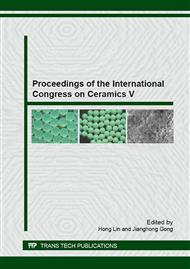p.41
p.45
p.49
p.53
p.58
p.62
p.68
p.72
p.78
Effect of Carbon Black Content and Molding Pressure on the Thermal Conductivity of SiC/Si Ceramic Composites
Abstract:
SiC/Si ceramic composites have been considered as promising candidate materials for heat exchanger due to their good thermal conductivity and corrosion resistance. In this work, the SiC/Si ceramic composites were fabricated by liquid silicon infiltration technique, and the effect of carbon black content and molding pressure on thermal conductivity of the composites was studied. With carbon black content increasing from 5 wt. % to 25 wt. %, the thermal conductivity increased from 42.36 W/(m·K) to 65.60 W/(m·K) when molding pressure was fixed as 50 MPa. With molding pressure increasing from 30 MPa to 110 MPa, the thermal conductivity of SiC/Si ceramic composites with 20 wt. % carbon black content increased firstly, and then decreased, obtaining a maximum thermal conductivity of 71.62 W/(m·K) under 90 MPa. The SiC/Si ceramic composites with an optimal thermal conductivity of 76.55 W/(m·K) at room temperature were obtained when carbon black content and molding pressure were 25 wt. %, 90 MPa, respectively.
Info:
Periodical:
Pages:
58-61
Citation:
Online since:
July 2015
Authors:
Price:
Сopyright:
© 2015 Trans Tech Publications Ltd. All Rights Reserved
Share:
Citation:


